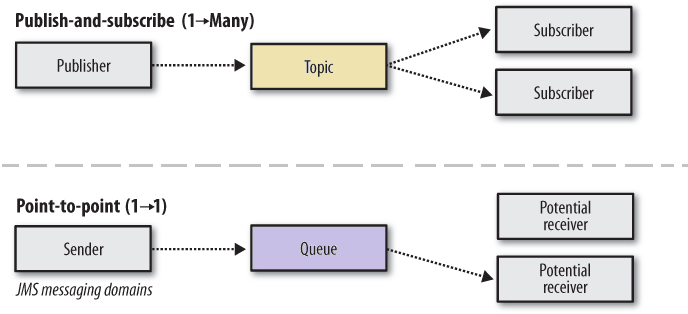# Messaging / Events
# Type of message model
- one-to-one communication (queuing model)
- one-to-many (Pub/Sub model)
- asynchronous communication

# Performance characterization
Scalability
How system is able to handle increases in load without noticeable degradation of latency & availability. Here, load can mean things such as the no. of topics, consumers, producers, messages / sec, ...
Availability
In a distributed system, a variety of problems can occur at a unit level( servers, disks, network, and so on). The system's availability is a measure of how resilient the system is to these failures so that it is available to end users.
Latency
how much time it taks for a message to get to a consumer from a producer.
Throughput
how many messages can be processed / sec by messaging system.
# Broker-based messaging
- A broker is a component that acts as the intermediary in messaging system.
- The clients connect to the broker and not to each other directly
- Producers connect to the broker & send messages to a specific queue.
- Consumers connect to the broker & specify queue name from which they want to read messages.
# Broker responsibilities:
- Maintaining the mapping of queues, producers, and consumers reliably: storing the messages in a durable format
- Handling message production: storing messages written by the producers
- Handling message consumption: ensuring that consumers reliably get messages & providing constructs to avoid duplicate messages.
- Routing and transformation: may transform or maintain multiple copies for each mesages to enable various topology models.
Advantages
- There is clear segregation btw connected services.
- Producer & consumer lifetimes don't have to overlap.
Disadvantages
- The broker can become a bottleneck, where all messages need to squeeze through. This can affect performance
- There is not network I/O which is absolutely necessary
# Event broker as Scatter-Gather component
Event broker can often be considered a Scatter-Gather component in microservice architectures.
- Scattering: When an event is published to the event broker, it is broadcast to multiple subscribers (microservices) that are interested in that event. This is similar to the "scattering" phase of the Scatter-Gather pattern, where a task or data is distributed to multiple workers.
- Gathering: While there's no explicit "gathering" phase as in the traditional Scatter-Gather pattern, the event broker acts as a centralized point where multiple microservices can asynchronously receive and process the same event. This effectively gathers the responses from different components, though not in a synchronized or coordinated manner.
# Models
# Queuing Model
- If more than 1 consumer is registered in the queuing model, each message is delivered to only one consumer, thereby enabling load-balancing semantics for message consumption & processing.
- There are 2 ways in which consumers can get to the messages:
- Pull mode: the messaging client in the consumer periodically polls the broker to check for any new messages.
- Push mode: the consumers register an endpoint and produced messages are sent to the URL using protocols such as HTTPs
POST
# Pub/Sub Model
- Each consumer gets a copy of the message.
- Messaging systems also provide load balancing semantics with Topics using something called virtual topics
Note: Read more about virtual topic (opens new window)
# Event driven architecture

# Delivery semantics
# At-least-once delivery
The Broker ensures that it will deliver every required message at least once to the Consumer. Most of the time, a message will be received only once, but sometimes duplicates might arise.
NOTICE
To avoid duplicate processing, the Consumer would need to deduplicate message on its side.
# At-most-once delivery
Sometimes it is essential to avoid sending duplicate messages, such as emails - don't want to spam your customer.
# Exactly-once delivery
Exactly-once semantics is the most desirable guarantee, but is impossible to guarantee without some sort of cooperation between the broker & the consumer.
- If the broker uses acknowledgements to producers for publishing message, each message must have
unique IDsfor the broker to deduplicate retires. - On consumer side, deduplication can be used to ensure that duplicate message are not processed.
# Resilience
A lot of things can go wrong with models:
The broker can fail, which takes away any messages stored on it.- To overcome this eventuality, generally brokers are deployed in a cluster of redundant instances.
- Every message is replicated on a set of machines as part of the write commit. If a message is replicated on to n brokers, that means the system can tolerate failure of *n-*1 instances.
The producer-to-broker communication can fail, which causes messages to be losts.- This is generally solved by acknowledgements
- Duplicate messages being produced can be avoided by having a sequence number for messages.
The consumer-to-broker message communication can fail, which causes messages to be losts.- Hence, messages should not be deleted from the Broker, unless there is an explicit acknowledgement from the consumer that the message has been processed.
# Order of messages
# Order in producing messages
Example we have "PostCreated" then "PostTitleUpdated", when The producer-to-broker communication can fail, in distributed system the order of message in broker can be wrong.
Solution:
- Use a UndispatchedEvent with a schedule sender
- After publish successfully, sender will remove rows in table
- Can send multiple events at a same time as long as aggregate_id different
| Field | Desc |
|---|---|
| event_id | PK - as a deduplicate id in broker |
| aggregate_id | root of aggregate, different aggregate_id can be sent in parallelly |
| created_at | timestamp (use this field to make sure the order) |
| event_payload | body of event |
Outbox pattern 
See more:
# Order in receiving messages
Solution, routing the relevant messages to a consumer
- use the partition key / group id of broker
Understanding Kafka Topic Partitions (opens new window)